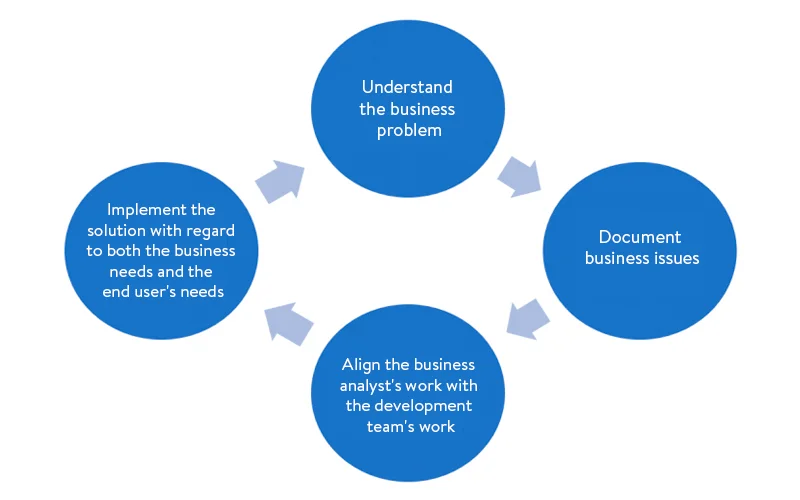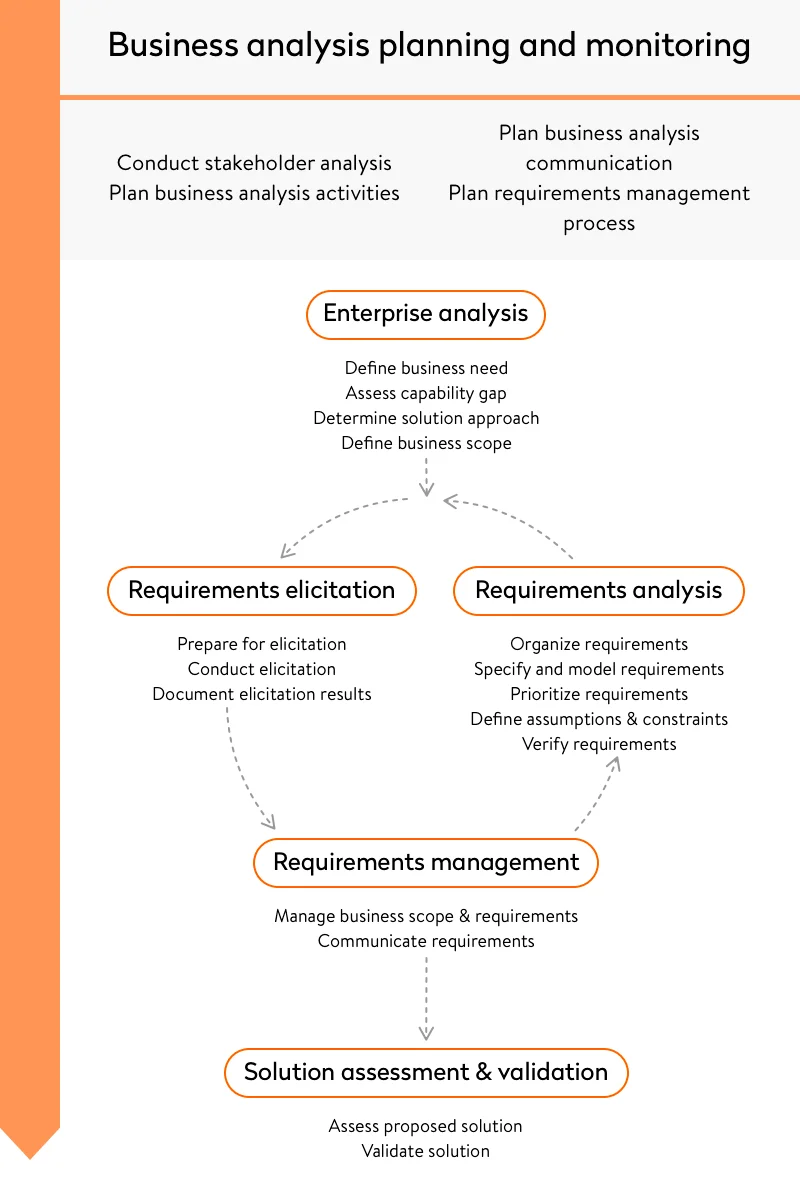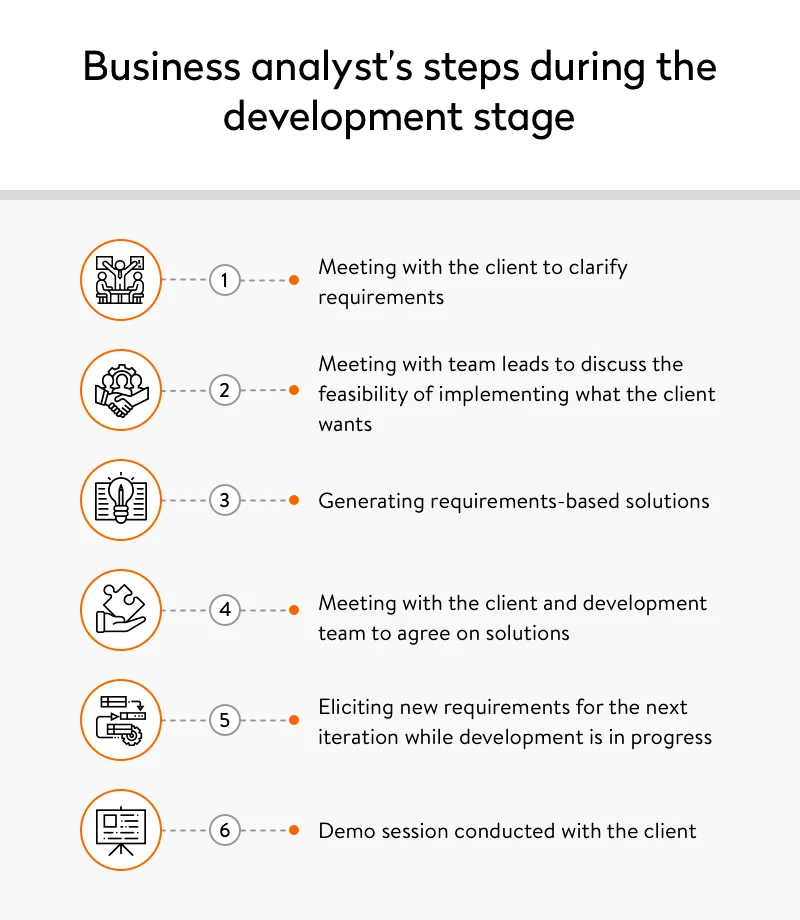A project needs a business analyst like a person needs air to breathe. Does that sound too pompous? It’s true nevertheless. Let us explain why.
One of the main challenges during negotiations and up to the product release is to avoid sinking in unnecessary details and blindly copying others. If these things happen, the software developed won’t serve its purpose and the business will suffer.
Say a client asks us to build a solution for speeding up employee onboarding and suggests specific features. Getting to the root of the problem first – instead of hastily implementing possibly unnecessary features – is the more effective approach. And this is when comprehensive business analysis services are a good idea. In this article, we are going to talk about the role of a business analyst in an IT company.
Business analysis in a nutshell
Instead of building the app a client wants, we aspire to build an app that serves our client’s business needs by providing strategic planning. To discover those needs, our client’s contribution is vital, as they know their business better than anybody. We ask a client to share with us the particularities of their field of activity, target audience, and competitors.
It’s difficult to overestimate the role of an IT business analyst who clarifies business requirements and unspoken nuances as well as validates the client’s specifications. Such an approach helps us build software with an eye on the end user.

Requirements elicitation at Yalantis
A software requirement is a description of a software system’s functionality. Requirements elicitation isn’t about transcribing what a client says. It’s a collaborative and analytical process that includes collecting, discovering, extracting, and defining business, user, functional, and nonfunctional requirements.
Requirements are gathered from uncategorized product-related information including product descriptions, features, types of users, sketches of screens, design references, links to competitors’ apps, and other documents that have been piling up on your desk for the past few months. All this information needs to be worked out by a software business analyst. In the next section, we’ll explain this process.
Discover more details on how we approach requirement elicitation and what deliverables you get to speed up and reduce costs for software development.
DOWNLOAD YALANTIS BA APPROACHBusiness analyst’s contribution to the project
A business analyst is dedicated to making sure that your app serves your business needs. That’s why a business analyst joins your team at the very beginning – at the negotiation stage – to help prepare an offer. During the discovery stage (preparation for development), the business analyst’s work gathers pace.

Check out the app development stages at Yalantis in our article on the role of a project manager in the app development process.
Discovery
All project deployment processes at Yalantis are templated and documented. This helps our business analysts elicit requirements faster and more clearly. Here’s the list of documents and actions our business analysts focus on during the discovery stage.
Business model canvas. This visual template organizes elements of our client’s business model. We use it as a supplement to other materials needed for the project.
Value stream. This artifact helps to understand the scope of work within and beyond the system. It also allows us to figure out the roles and elements of the app, the sequence of development, and who’s responsible for what. The value stream is regularly updated and elaborated.
Competitor analysis. This analysis is conducted to understand what similar solutions are already on the market and what we can suggest to our client so they can successfully occupy their niche.
Business objective model. This model helps us outline all the problems with a business at different levels and come up with suitable solutions to each. For instance, top management tends to see major issues while middle management tends to look inward, seeing issues in processes and resources. The business objective model is intended to embrace all issues.

Feature map (user story map). The feature map aims to outline the work to do in order to build the most delightful user experience. The feature map enables us to picture the product as a series of tasks performed by a user.
Development product backlog. This is a prioritized list of work for the development team. The business analyst creates a product backlog along with a solution architect, who suggests what technologies to use for development. Then a project manager validates these suggestions.
Product vision board. A product vision board is the result of all the above-mentioned steps. It outlines the product, its users, their problems and how the product solves them, the client’s business objectives, and success criteria (for example, number of users and functionality).

We acquaint a client with each of the artifacts mentioned above to explain our findings. We also demonstrate the proposed solutions to a client. At the end of the discovery stage, we have an estimated feature map, which enables us to proceed to development. But the business analyst’s work continues during the development stage.
Development
At the beginning of the development process, the business analyst clarifies and details requirements by communicating with the team and client. Then the business analyst generates requirements-based solutions and approves them with the client.
The business analyst also monitors designers’ progress to make sure the app design meets requirements. The app design is periodically sent to the client for approval and changes are made at the client’s request.

Read also: How Do We Deal with the App Development Process at Yalantis?
Demo session
During a demo session, a business analyst demonstrates the results of the development team’s work. As a result of a demo session, the business analyst fills in a demo repository, which includes notes related to the demo session and demo agenda. Thereby, every piece of information is stored in one place and is easy to find. After the demo session, the business analyst updates the product specification, which is also templated.
Product specification
The business analyst is responsible for updating the product specification. This document describes the status of a product under development and simplifies project transfer within our company, to another vendor, and to the client (when the product is fully developed).
Product release
At the product release stage, the client receives an updated product specification. We also conduct a final demo session to clarify all details related to the developed product and its use. It’s also common practice for Yalantis to offer the scope of work for the second product version.
The business analyst does their best to minimize the number of changes that developers might have to make during development. By doing this, the business analyst helps to save time and money along with helping the client gain a clear vision of the product. As a result, the client receives a product that’s even better than they expected.
Now that you know how proper business analysis should be performed and understand the role of a business analyst in software development, make sure your software provider offers a quality business analysis outsourcing. If you need to improve your business processes, we’ll be glad to build an efficient software solution.
Seeking for a software development partner?
Yalantis will gladly consult you
Let’s discuss your ideaRate this article
4.4/5.0
based on 1,402 reviews





